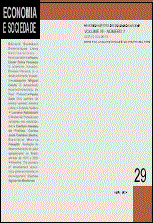Resumo
Fluxo de capitais é um importante elemento no crescimento econômico por diversos motivos. Um deles é porque ele alivia a restrição no balanço de pagamentos de acordo com a Lei de Thirlwall. A explicação é que pelo fato de ocorrer uma elevação no nível de importações quando há um crescimento da renda de uma determinada economia deverá ocorrer uma entrada de recursos via exportações ou fluxo de capitais para que seja possível o fechamento do balanço de pagamentos (BP). O foco do presente trabalho está na avaliação de como o fluxo de capitais afetou o crescimento da economia brasileira no período 1947-2000, considerando que as elasticidades-renda das importações mudam ao longo do tempo.
Abstract
Thirlwall's Model with elasticities changes Thirlwall's Model with elasticities changes Capital flows are expected to be important in the process of economic growth for several reasons. One of them is their importance in relaxing the balance of payments constraints as envisaged by Thirlwall’s law, which states that when economic growth takes place, the level of imports also grows. Consequently, there is an increase in the export level or in the volume of capital inflows as imposed by the balance of payment constraints. The goal of the present paper is to investigate how capital flows have stimulated the Brazilian economy by means of Thirlwall’s model in the 1947- 2000 period of time, taking into consideration that income elasticity of imports changes over time.
Key words: income elasticity of imports. capital flows. balance of payment constraint
Referências
ATESOGLU, H. S. Growth and fluctuations in the USA: a demand-oriented explanation. In: SETTERFIELD, M. (Ed.). The economics of demand led growth, challenging the supply-side vision of the long-run. [s.n.t.], 2002. p. 55-63.
________. A demand-oriented explanation of economic growth in Germany. Journal of Post Keynesian Economics, v. 19, n. 1, p. 101-111, Fall 1996.
BARBOSA, F. H. Crescimento de longo prazo, desindustrialização e política monetária, Brasil x Coréia – 1960: Brasil 3x2 Coréia do Sul, 2000: Coréia do Sul 2x1 Brasil. Boletim Economia & Tecnologia, Centro de Pesquisas Econômicas (CEPEC) da Universidade Federal do Paraná, ano 2, v. 4, p. 5-8, 2006.
BARBOSA-FILHO, N. H. (2001). The balance of payments constraint: from balanced trade to sustainable debt. New York: Center for Economic Policy Analysis, 2002. p. 1-24.
(Working Paper, n. 6).
________. Growth, exchange rates and trade in Brazil: a structuralist post-Keynesian approach. Nova Economia, v. 14, n. 2, p. 59-86, 2004.
BÉRTOLA, L.; HIGACHI, H.; PORCILE, G. Balance of payments constraint growth in Brazil: a test of Thirlwall’s Law, 1890-1973. Journal of Post-Keynesian Economics, v. 25, n. 1, p. 123-140, 2002.
JAYME JR., F.G. Balanced-of-payments constrained economic growth in Brazil. Belo Horizonte: Cedeplar/UFMG, 2001. p. 1-27. (Texto para Discussão, n. 155).
KALDOR, N. The role of effective demand in the short run and the long run. In: BARRÈRE, A. (Ed.). The Foundation of Keynesian Analysis – Proceedings of a Conference held at the University of Paris I – Panthéon-Sorbonne, p. 153-160, 1988.
KRUGMAN, P. Differences in income elasticities and trends in real exchange rates.
Cambridge, MA: National Bureau of Economic Research, 1988. p. 1-37. (NBER Working Paper, n. 2761).
MCCOMBIE, J. S. L.; ROBERTS, M. The role of the balance of payments in economic growth. In: SETTERFIELD, M. (Ed.). The economics of demand led growth, challenging the supply-side vision of the long-run. [s.n.t.], 2002. p. 87-114.
________; THIRLWALL, A. P. Economic growth and the balance-of-payments constraint. Grã-Bretanha: Macmillan Press LTD, 1994.
________; ________. Economic growth and the balance of payments revisited. In: ARESTIS, P. PALMA, G.; SAWYER, M. (Ed.). Markets, unemployment and economic policy: essays in honour of Geoffrey Harcout. London: Routledge, 1997. v. 2, p. 498-511.
MADDISON, A. The political economy of poverty, equity, and growth, Brazil and Mexico. Oxford: World Bank, Oxford University Press, 1992. (A World Bank Comparative Study).
MORENO-BRID, J. C. On capital flows and the balance-of-payments-constraint growth model. Journal of Post Keynesian Economics, v. 21, n. 2, p. 283-298, 1998.
NAKABASHI, L. Crescimento com restrição no Brasil: uma abordagem com diferentes elasticidades. Belo Horizonte: Cedeplar/UFMG, 2003. p. 1-18. (Texto para Discussão, n. 203).
OREIRO, J. L. Desenvolvimento numa perspectiva keynesiana: uma resposta ao professor Fernando de Holanda Barbosa. Boletim Economia & Tecnologia, Centro de Pesquisas Econômicas (CEPEC) da Universidade Federal do Paraná, ano 2, v. 4, p. 9-18, 2006.
PARK, H. M. Testing normality in SAS, STATA, and SPSS. 2003. Disponível em: <http://pytheas.ucs.indiana.edu>. Acesso em 9 ago. 2006.
PORCILE, G.; CURADO, M. Rigidez na balança comercial e movimentos de capital: uma abordagem estruturalista. Revista Brasileira de Economia, v. 56,n. 3, p. 483-495, 2002.
________; ________; BAHRY, T. R. Crescimento com restrição no balanço de pagamentos e “fragilidade financeira” no sentido minskyano: uma abordagem macroeconômica para a América Latina. Economia e Sociedade, Campinas, v. 1, n. 1, p. 25-41, 2003.
THIRLWALL, A. P. The balance of payments constraint as an explanation of international growth rate differences. Banca Nazionale del Lavoro Quarterly Review, n. 128, Mar. 1979.
________; HUSSAIN, M. N. The balance of payments constraint, capital flows and growth rate differences between developing countries. Oxford Economic Papers, v. 10, p. 498-509, 1982.
A Economia e Sociedade utiliza a licença do Creative Commons (CC), preservando assim, a integridade dos artigos em ambiente de acesso aberto.

